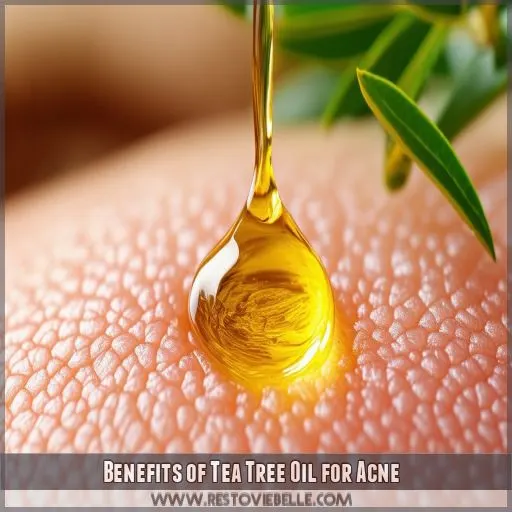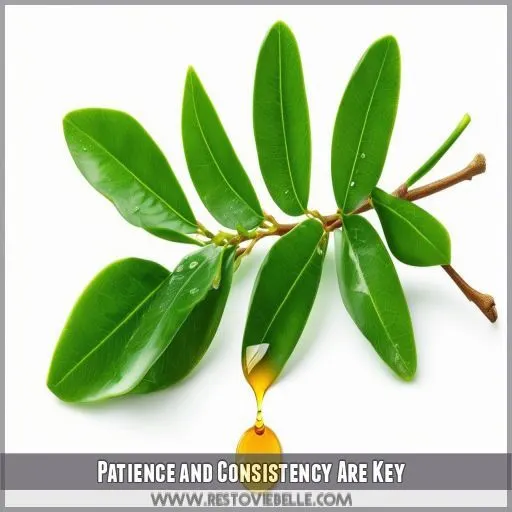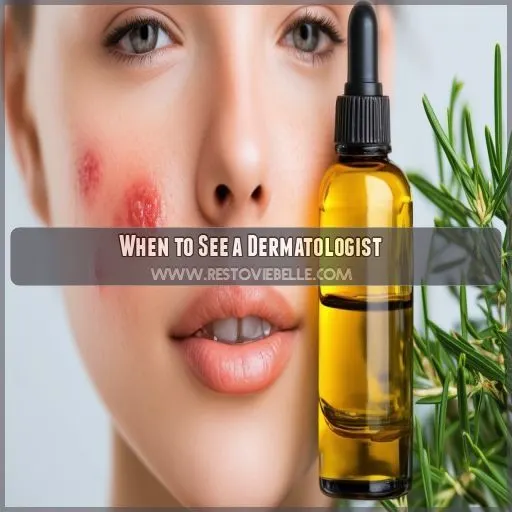This site is supported by our readers. We may earn a commission, at no cost to you, if you purchase through links.

We outline the pros, methods for proper application, and precautions. Whether you’re battling periodic breakouts or chronic acne, the key to clearer, healthier-looking skin could be knowing how to harness tea tree oil.
Let’s start with a step-by-step guide on how to use this potent natural treatment
Table Of Contents
- Key Takeaways
- What is Tea Tree Oil?
- Benefits of Tea Tree Oil for Acne
- How to Use Tea Tree Oil for Acne
- Precautions and Safety
- Choosing a Tea Tree Oil Product
- Other Uses for Tea Tree Oil
- Combining Tea Tree Oil With Other Acne Treatments
- Patience and Consistency Are Key
- Alternatives to Tea Tree Oil for Acne
- When to See a Dermatologist
- Frequently Asked Questions (FAQs)
- Does tea tree oil gel help with acne?
- Is drinking green tea good for acne prone skin?
- Should you use tea tree oil for acne blemishes?
- Can tea tree oil cause acne?
- Can tea tree oil remove acne scars?
- Is tea tree oil effective for hormonal acne?
- How long does tea tree oil last once opened?
- Can tea tree oil be used during pregnancy?
- Does tea tree oil work on cystic acne?
- Conclusion
Key Takeaways
- Tea tree oil is your new secret weapon against acne! This natural wonder packs a serious punch with its antibacterial and anti-inflammatory properties. Just remember, a little goes a long way – dilute it properly or your face might throw a fit.
- Consistency is key, folks. Apply your tea tree oil concoction twice daily, morning and night, like clockwork. Rome wasn’t built in a day, and neither is clear skin. Stick with it, and you’ll be on your way to selfie-ready skin in no time.
- Don’t put all your eggs in one basket. While tea tree oil can work wonders, it’s not a miracle cure for everyone. If you’re still battling breakouts after 12 weeks, it might be time to call in the big guns and consult a dermatologist.
- Safety first! Always do a patch test before slathering your face with tea tree oil. And whatever you do, don’t get any ideas about drinking the stuff – unless you fancy a trip to the ER. Keep it on your skin, not in your system!
What is Tea Tree Oil?
Tea tree oil is an essential oil derived from the leaves of Melaleuca alternifolia, a tree indigenous to Australia. Probably, you know about its antimicrobial and antibacterial properties, which make it among the most popular natural remedies applied to all kinds of skin problems, acne included.
While it’s potent stuff, use it carefully. If not correctly diluted, tea tree oil has been known to irritate the skin.
Now, don’t be scared off by that. This natural wonder may very well turn out to change the game in your skin care routine if applied correctly.
Let’s dive into how to harness its acne-fighting power safely and effectively
Benefits of Tea Tree Oil for Acne
Tea tree oil offers several potential benefits for acne-prone skin. It can reduce acne-causing bacteria, help dry out pimples, decrease inflammation, and may improve mild to moderate acne when used consistently
Reduces Acne-causing Bacteria on the Skin
Tea tree oil’s potent antibacterial properties make it a formidable ally against acne-causing bacteria, particularly Cutibacterium acnes. Unlike harsh alternatives like benzoyl peroxide, it’s gentler on your skin. For best results, dilute it with a carrier oil and apply as a spot treatment. Remember, consistency is key when battling those pesky pimples!
Helps Dry Out Pimples and Reduce Inflammation
Tea tree oil’s antibacterial properties and anti-inflammatory agents make it a powerful ally in your fight against acne. As a natural solution, it helps:
- Dry out pesky pimples
- Reduce redness and swelling
- Potentially shrink pores
When used as a spot treatment, it can effectively target blemishes. However, be mindful of potential skin irritation concerns with essential oils
May Improve Mild to Moderate Acne
Tea tree oil’s effectiveness for mild to moderate acne is promising. When applied topically, it can reduce inflammation and fight acne-causing bacteria. For best results, use a diluted concentration of 5-15%. While it may not be as potent as some oral treatments, tea tree oil offers a gentler, long-term skin care option with minimal irritation
How to Use Tea Tree Oil for Acne
To effectively use tea tree oil for acne, apply it twice daily, once in the morning and once at night. After each application, follow up with a gentle moisturizer to help maintain your skin’s natural balance and prevent dryness
Use Twice Daily, Morning and Night
To use the tea tree oil on your acne effectively, apply it twice daily, once in the morning and once at night. Here is how to do it safely:
- Mix 1 or 2 drops of the tea tree oil in 12 of the carrier oils, such as jojoba or coconut oil.
2Do the patch test first before full application to ensure that there are no adverse reactions
- Apply mixture on clean and dry skin with a cotton swab
- For a lighter version, mix with hyaluronic acid serum.
Follow With a Gentle Moisturizer
After using tea tree oil, a gentle skin moisturizer is all the more needed. This helps to normalize skin and prevent dryness, which, in turn, prevents additional irritation.
Use a non-comedogenic moisturizer because the last thing you want is clogged pores after all this work. From this point, if you use your diluted tea tree oil in a carrier oil, that can be your hydration.
If your skin feels a little tight or dry after application, apply a light film of moisturizer. Remember, everybody’s skin is different, so be sure to patch test first to avoid allergic reactions.
Your skin is going to love this extra pampering
Precautions and Safety
Before applying tea tree oil to your face, however, make sure that a patch test is done first to check on any potential reactions. In case of irritation or redness, discontinue the use of this product. Keep the oil out of your eyes, and don’t ingest it.
Perform a Patch Test Before Using on the Face
Always do a patch test on your face before applying the tea tree oil. Follow proper ratios and dilute with any carrier oil. Apply a little on the inner arm and wait 24 hours to check if you have sensitive skin or are generally allergic.
Discontinue Use if Irritation or Redness Occurs
If irritation or a skin reaction of any kind occurs from using tea tree oil, please discontinue use. Your skin’s sensitivity isn’t darned. Testing is necessary, though ceasing usage at the first ol’ sign of trouble may be imperative. Don’t push through discomfort; your skin health comes first.
Avoid Contact With Eyes
While tea tree oil‘s great for acne, keep it away from your eyes. The potent oil can cause severe irritation or allergic reactions. Always use caution and consider wearing eye protection during application. If contact occurs, rinse thoroughly with clean water immediately
Do Not Ingest Tea Tree Oil
While avoiding eye contact, remember that ingesting tea tree oil is a big no-no. It can be toxic if swallowed, leading to serious side effects. Here’s what you need to know:
- Tea tree oil toxicity can cause nausea and confusion
- Ingestion may result in severe poisoning
- Keep it out of reach of children and pets
Choosing a Tea Tree Oil Product
Considering the tea tree oil for acne treatment, pick 100% pure and undiluted tea tree oil for optimal action. If possible, opt for an organically and sustainably sourced variation. This may provide additional benefits as far as the environment is concerned.
Look for 100% Pure, Undiluted Tea Tree Oil
To treat acne, 100% pure tea tree oil should not be the only option. It will not give you all the help you need without additions.
Remember that tea tree oil is potent and must be diluted before use. Shake the bottle well before use.
A solution can be made to about 5% by mixing one part tea tree oil with 19 parts carrier oil. Always do a patch test before applying to the face, as some may encounter reactions on the skin.
If you’re in any doubt about the dilution ratios, or if you’re susceptible to allergic reactions, then you should contact a dermatologist for personalized advice on how to utilize tea tree oil safely
Opt for Organic and Sustainably Sourced if Possible
Choose beyond simply pure and undiluted, opting for organic and sustainably sourced tea tree oil varieties when available. These products are often produced with integrity and employ practices that are friendly to the environment.
Look for labels that signify organic sourcing and fair trade certifications. By selecting these options, you’ll not only receive high-quality products for your acne treatment, but you’ll also support sustainable practices within the industry
Other Uses for Tea Tree Oil
While tea tree oil is known for its acne-fighting properties, it has several other beneficial uses for skin and hair health. You can apply diluted tea tree oil to treat fungal infections like athlete’s foot, reduce dandruff and scalp conditions, or soothe eczema and other skin irritations
Treating Fungal Infections Like Athlete’s Foot or Nail Fungus
Tea tree oil isn’t just for acne; it’s a powerful ally against fungal infections too. You can harness its antifungal properties for:
- Treating toe and toenail fungus
- Soothing athlete’s foot
- Killing stubborn nail infections
Apply diluted tea tree oil directly to affected areas twice daily. Remember, consistency is key when tackling these pesky problems
Reducing Dandruff and Treating Scalp Conditions
Tea tree oil isn’t just for acne and fungal infections. It’s a versatile remedy for scalp issues too. You can harness its power to combat dandruff, soothe scalp psoriasis, and even tackle pesky lice. Here’s how tea tree oil can help with common scalp conditions:
| Condition | Tea Tree Oil Benefits |
|---|---|
| Dandruff | Reduces flaking and itching |
| Scalp Psoriasis | Calms inflammation |
| Hair Loss | May stimulate hair growth |
| Lice | Natural repellent and treatment |
Soothing Eczema and Other Skin Irritations
Tea tree oil’s versatility extends beyond acne and dandruff. It can also soothe eczema and other skin irritations, thanks to its anti-inflammatory and antifungal properties. When using tea tree oil for eczema relief, remember to:
- Dilute it properly with a carrier oil
- Perform a patch test first
- Apply sparingly to affected areas
Always consult your dermatologist before trying new treatments
Combining Tea Tree Oil With Other Acne Treatments
You can try mixing tea tree oil with other acne treatments to enhance their efficacy maybe. However, it’s essential that you consult a dermatologist before mixing treatments, as some mixes may either cause skin irritation or reduce effectiveness.
May Enhance the Effects of Other Acne Treatments
You might be wondering if tea tree oil plays well with other acne treatments. Good news – it often does! When combined with common acne-fighters like benzoyl peroxide, salicylic acid, or retinoids, tea tree oil may boost their effectiveness. It’s like having a trusty sidekick in your skincare routine.
However, proceed with caution. Start by using tea tree oil and your other treatments on alternate days to see how your skin reacts. If all’s well, you can gradually increase frequency
Patience and Consistency Are Key
Be very patient with tea tree oil in treating acne—it takes a while to work. Application should be done religiously for several weeks, but after 12 weeks, if you find no improvement, it’s time to see a dermatologist for professional advice.
It May Take Several Weeks to See Results
You’ll need patience when using tea tree oil for acne. Its effects aren’t instant, and it may take several weeks to see noticeable improvements. The tea tree concentration and your individual skin response play a role in this timeline. If you’re not seeing results, don’t lose hope – natural remedies often require time to work their magic
Use Tea Tree Oil Consistently for Best Effects
Consistency is key when using tea tree oil for acne. Stick to your daily application routine, following the recommended dosage. Don’t get discouraged if you don’t see immediate results – tea tree oil’s effectiveness builds over time. Be patient and watch for any signs of irritation. Remember, good things come to those who wait!
If No Improvement After 12 Weeks, Consult a Dermatologist
If you have been using tea tree oil continuously for 12 weeks and there’s no improvement at all, then you need to visit a dermatologist.
Otherwise, it seems to work miracles for most people. The professional will help you identify its long-term effect on your skin and the interaction with your skin type. They can also recommend various alternative natural treatments or optimal formulations, all in one go.
Never hesitate to seek expert advice about any stubborn acne
Alternatives to Tea Tree Oil for Acne
While tea tree oil can be effective for some, it’s not the only option for treating acne. You might also consider alternatives like benzoyl peroxide, salicylic acid, retinoids, antibiotics, or hormonal therapies, depending on your skin type and the severity of your acne
Benzoyl Peroxide
While tea tree oil requires patience, benzoyl peroxide offers quicker results. This powerful acne-fighter:
- Kills acne-causing bacteria
- Reduces inflammation
- Unclogs pores
- Comes in various strengths
Consider potential side effects and proper dosage before use
Salicylic Acid
Unlike benzoyl peroxide, salicylic acid doesn’t kill bacteria. It’s a chemical exfoliant that unclogs pores and reduces inflammation. You’ll find this acne-fighting ingredient in many over-the-counter products, from cleansers to spot treatments
Retinoids
Retinoids, in the form of topical or oral drugs, can be very effective when fighting acne. They work by facilitating cell turnover and unclogging pores. Consider discussing retinoid options with your dermatologist for a tailored treatment plan
Antibiotics
Unlike tea tree oil, which works locally, antibiotics usually work systemically against the reproduced acne-causing bacteria for more effectiveness. They’re prescribed in most severe cases of acne. However, given possible interaction with tea tree oil, one has to consult a doctor for the best combination of treatments for effectiveness.
Hormonal Therapies
If tea tree oil isn’t cutting it, hormonal therapies might help. These options target acne caused by hormonal imbalances:
- Birth control pills
- Spironolactone
- Anti-androgen medications
- Isotretinoin for severe cases
Always consult a dermatologist before starting hormonal treatments
When to See a Dermatologist
Although tea tree oil may be helpful for very mild acne, people with severe acne, cystic acne, or acne that won’t go away should work with a dermatologist, especially when acne leads to scarring or hurts a person emotionally. Visiting a dermatologist can establish the root cause of acne and, therefore design a holistic treatment regime for the acne sufferer.
For Severe, Cystic, or Persistent Acne
If tea tree oil isn’t helping your severe or cystic acne, it’s time to see a dermatologist. They can prescribe stronger treatments like antibiotics, retinoids, or hormonal therapies. These may be combined with benzoyl peroxide or salicylic acid for enhanced effectiveness
If Acne is Causing Scarring or Emotional Distress
If acne’s leaving scars or affecting your mental health, it’s time to see a dermatologist. They’ll assess your situation and might recommend:
- Psychologist intervention for emotional support
- Endocrinologist consultation for hormonal imbalances
- Steroid treatment for severe inflammation
- Skin resurfacing for existing scars
Don’t wait; seek help now
To Determine the Underlying Cause of Acne
Visiting a dermatologist can help uncover the underlying cause of your acne. They’ll investigate potential dietary triggers, stress management needs, and hormonal imbalances. With their expertise, you’ll gain insights into necessary lifestyle changes, paving the way for clearer skin and better overall health
To Develop a Comprehensive Treatment Plan
A dermatologist can develop a specialized treatment plan once the underlying cause of your acne has been determined. They’ll look at:
- Your skin type
- Acne severity
- Lifestyle factors
This strategy can include tea tree oil’s anti-inflammatory functions with other forms of therapy, which is safe and efficient
Frequently Asked Questions (FAQs)
Does tea tree oil gel help with acne?
You’d think tea tree oil gel wouldn’t help with acne, but surprise! It can be effective. Tea tree oil’s antimicrobial properties may reduce acne-causing bacteria. Apply a thin layer twice daily, but don’t forget to patch test first
Is drinking green tea good for acne prone skin?
Yes, drinking green tea can benefit acne-prone skin. It’s rich in antioxidants that may reduce inflammation and regulate hormones. Aim for 2-3 cups daily, but don’t rely on it as your sole acne treatment
Should you use tea tree oil for acne blemishes?
You can use tea tree oil for acne blemishes; however, you must dilute it before applying. Mix 1-2 drops of tea tree oil with 12 drops of any other carrier oil and apply twice daily. Do the patch test first.
Can tea tree oil cause acne?
While tea tree oil generally helps combat acne, it can potentially cause breakouts in some cases. If you’re allergic or use it undiluted, it might irritate your skin, leading to inflammation and pimples. Always patch test first
Can tea tree oil remove acne scars?
While tea tree oil can help with active acne, it’s not proven to remove existing scars. You’d need targeted treatments like retinoids or laser therapy for scar reduction. However, it may prevent new scars by treating acne effectively
Is tea tree oil effective for hormonal acne?
Like a soothing balm for your skin’s hormonal storm, tea tree oil can be effective for hormonal acne. Its anti-inflammatory properties may help calm flare-ups, but results vary. You’ll want to use it consistently and combine it with other treatments
How long does tea tree oil last once opened?
Once opened, your tea tree oil can last up to 2 years if stored properly. Keep it in a cool, dark place and tightly sealed. You’ll know it’s gone bad if the scent changes or it looks cloudy
Can tea tree oil be used during pregnancy?
While tea tree oil’s antibacterial properties intrigue, its safety during pregnancy remains uncertain. You shouldn’t use it without consulting your doctor. Alternatives like benzoyl peroxide or glycolic acid might be safer options for treating acne during this time
Does tea tree oil work on cystic acne?
While tea tree oil has antimicrobial properties, it’s not typically effective for cystic acne. This deep, severe form of acne often requires professional treatment. You’d be better off consulting a dermatologist for targeted solutions to cystic breakouts
Conclusion
Treating troublesome acne with tea tree oil offers a natural, potentially effective solution. You’ve learned how to use tea tree oil for acne safely and effectively, from proper application to precautions.
While tea tree oil can be a powerful ally in your skincare routine, it’s just one tool in the acne-fighting arsenal. Always prioritize your skin’s health and seek professional advice when needed















